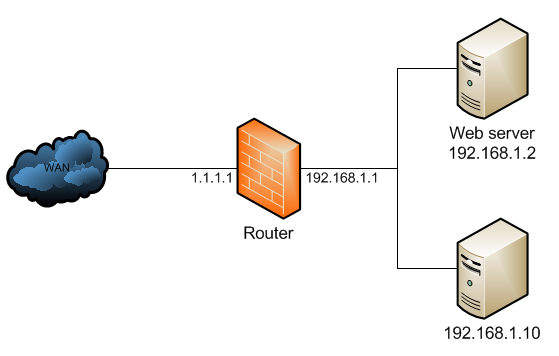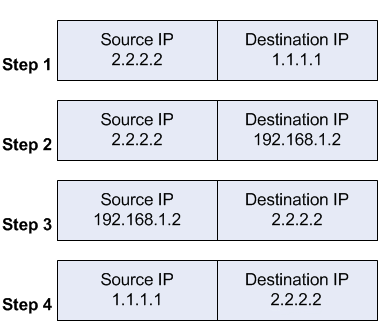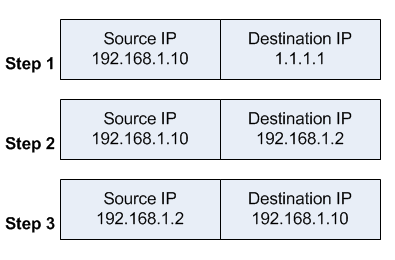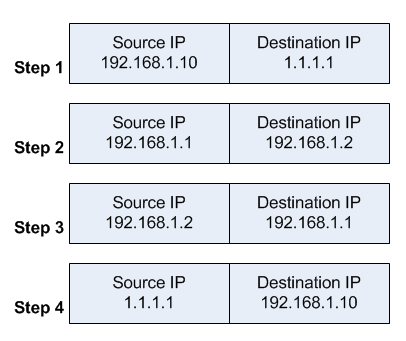RouterOS 设定NAT loopback (Hairpin NAT)回流
In the below network topology a web server behind a router is on private IP address space, and the router performs NAT to forward traffic to its public IP address to the web server behind it.

The NAT configuration would look like below:
/ip firewall natadd chain=dstnat dst-address=1.1.1.1 protocol=tcp dst-port=80 \ action=dst-nat to-address=192.168.1.2add chain=srcnat out-interface=WAN action=masquerade
When a client out on the Internet with IP address 2.2.2.2 establishes a connection to the web server, the router performs NAT as configured.

- the client sends a packet with a source IP address of 2.2.2.2 to a destination IP address of 1.1.1.1 on port tcp/80 to request some web resource.
- the router destination NATs the packet to 192.168.1.2 and replaces the destination IP address in the packet accordingly. The source IP address stays the same: 2.2.2.2.
- the server replies to the client's request and the reply packet has a source IP address of 192.168.1.2 and a destination IP address of 2.2.2.2.
- the router determines that the packet is part of a previous connection and undoes the destination NAT, and puts the original destination IP address into the source IP address field. The destination IP address is 2.2.2.2, and the source IP address is 1.1.1.1.
The client receives the reply packet it expects, and the connection is established.
When a client on the same internal network as the web server requests a connection to the web server's public IP address, the connection breaks.

- the client sends a packet with a source IP address of 192.168.1.10 to a destination IP address of 1.1.1.1 on port tcp/80 to request some web resource.
- the router destination NATs the packet to 192.168.1.2 and replaces the destination IP address in the packet accordingly. The source IP address stays the same: 192.168.1.10.
- the server replies to the client's request. However, the source IP address of the request is on the same subnet as the web server. The web server does not send the reply back to the router, but sends it back directly to 192.168.1.10 with a source IP address in the reply of 192.168.1.2.
The client receives the reply packet, but it discards it because it expects a packet back from 1.1.1.1, and not from 192.168.1.2. As far as the client is concerned the packet is invalid and not related to any connection the client previously attempted to establish.
To fix the issue, an additional NAT rule needs to be introduced on the router to enforce that all reply traffic flows through the router, despite the client and server being on the same subnet. The rule below is very specific to only apply to the traffic that the issue could occur with - if there are many servers the issue occurs with, the rule could be made broader to save having one such exception per forwarded service.
/ip firewall natadd chain=srcnat src-address=192.168.1.0/24 \ dst-address=192.168.1.2 protocol=tcp dst-port=80 \ out-interface=LAN action=masquerade

With that additional rule, the flow now changes:
- the client sends a packet with a source IP address of 192.168.1.10 to a destination IP address of 1.1.1.1 on port tcp/80 to request some web resource.
- the router destination NATs the packet to 192.168.1.2 and replaces the destination IP address in the packet accordingly. It also source NATs the packet and replaces the source IP address in the packet with the IP address on its LAN interface. The destination IP address is 192.168.1.2, and the source IP address is 192.168.1.1.
- the web server replies to the request and sends the reply with a source IP address of 192.168.1.2 back to the router's LAN interface IP address of 192.168.1.1.
- the router determines that the packet is part of a previous connection and undoes both the source and destination NAT, and puts the original destination IP address of 1.1.1.1 into the source IP address field, and the original source IP address of 192.168.1.10 into the destination IP address field.
The client receives the reply packet it expects, and the connection is established.
However, the web server only ever sees a source IP address of 192.168.1.1 for all requests from internal clients regardless of the internal client's real IP address. There is no way to avoid this without either using a router that can do application level DNS inspection and can rewrite A records accordingly, or a split DNS server that serves the internal clients the internal server IP address and external clients the external server IP address.
This is called - among other terms - hair pin NAT because the traffic flow has clients enter the router through the same interface it leaves through, which when drawn looks like a hair pin.
RouterOS 设定NAT loopback (Hairpin NAT)回流的更多相关文章
- Linux 与 CONE NAT 和 Symmetric NAT
http://alexanderlaw.blog.hexun.com/31883661_d.html 1. NAT 的划分 RFC3489 中将 NAT 的实现分为四大类: 1. Full Cone ...
- 静态NAT、动态NAT
静态NAT.动态NAT 实验拓扑: 实验目的:熟悉网络地址转换协议 掌握静态NAT 和动态NAT的配置 分析静态NAT 和动态NAT的区别 使用show命令来检查NAT的运行情况 实验要求:按拓扑图来 ...
- 运营商级NAT(Carrier-grade NAT)
运营商级NAT(Carrier-grade NAT) 运营商级(Carrier-grade)NAT,是用于缓解是IPV4地址枯竭的一种方法,通过这种方法,原来被分配公网ip的端点.家庭网络等可以被 ...
- CONE NAT 和 Symmetric NAT
CONE NAT 和 Symmetric NAT 1. NAT 的划分 RFC3489 中将 NAT 的实现分为四大类: Full Cone NAT 完全锥形 NAT Restricted Cone ...
- 什么叫NAT,设置NAT的两个方法
NAT是网络地址翻译就是把公网IP翻译成私有地址, 又叫端口映射或端口转发. 采用路由方式是指ADSL拥有一个动态或固定的公网IP,ADSL直接接在HUB或交换机上,所有的电脑共享上网.这时ADSL的 ...
- NAT and Traversal NAT(TURN/STUN/ICE)
http://www.cnblogs.com/whyandinside/archive/2010/12/08/1900492.html -------------------------------- ...
- 静态NAT、动态NAT、PAT(端口多路复用)的配置
静态NAT.动态NAT.PAT(端口多路复用)的配置 NAT的实现方式有三种,即静态转换Static Nat.动态转换Dynamic Nat 和 端口多路复用OverLoad. 静态转换 ( ...
- NAT原理与NAT穿越
最近在看东西的时候发现很多网络程序中都需要NAT穿越,特意在此总结一下. 先做一个约定: 内网A中有:A1(192.168.0.8).A2(192.168.0.9)两用户 网关X1(一个NAT设备)有 ...
- NAT与FULL NAT的区别
LVS 当前应用主要采用 DR 和 NAT 模式,但这 2 种模式要求 RealServer 和 LVS在同一个 vlan中,导致部署成本过高:TUNNEL 模式虽然可以跨 vlan,但RealSer ...
随机推荐
- SQL语句执行过程详解
一.SQL语句执行原理: 第一步:客户端把语句发给服务器端执行 当我们在客户端执行select语句时, 客户端会把这条SQL语句发送给服务器端,让服务器端的进程来处理这语句.也就是说,Oracle客户 ...
- ZEDGRAPH画图心得
OleDbConnection odcConnection = new OleDbConnection(MyConnectionString); //打开连接 C#操作Access之按列读取mdb o ...
- grafana+influxdb+telegraf监控服务器cpu,内存和硬盘
随便抄了一篇,目前我们的项目也在用,这个是linux和windows通吃的一种监控方案,非常有效,详细和优美,需要监控什么具体的业务内容,自己向influxdb中插入就行了. 监控服务器状态是运维必不 ...
- tmux安装与使用
安装 用法 重点 一prefix前缀键 二window和pane的区分 tmux 按照官方给出的介绍是:终端复用工具.说白了就是可以仅仅在开启一个终端的情况下同时处理多个任务. 比如下面我设置的这样一 ...
- UI基础:target...action设计模式,手势识别器.UIimageview
使用target..action和delegate设计模式可以实现解耦.使代码更加优化. 手势识别器: 手势识别器:是对触摸事件做了封装,无需自己去判断某个手势是否触发,手势识别器本身起到了识别作用, ...
- 基于VUE2.0的分页插件(很好用,很简单)
基于jQuery的分页插件很多,今天分享一下基于Vue的分页插件pagination.js,该插件使用用感觉很不错,简单不复杂,现将个人使用过程中的方法与遇到的问题以及实例分享出来. 下载解压的主要目 ...
- 题目1003:A+B
题目1003:A+B 时间限制:1 秒内存限制:32 兆 题目描述: 给定两个整数A和B,其表示形式是:从个位开始,每三位数用逗号","隔开. 现在请计算A+B的结果,并以正常形式 ...
- Python中的import
模块(module):用来从逻辑(实现一个功能)上组织Python代码(变量.函数.类),本质就是*.py文件.文件是物理上组织方式"module_name.py",模块是逻辑上组 ...
- Hibernate4获取sessionFactory
/** * Location of hibernate.cfg.xml file. * Location should be on the classpath as Hibernate uses * ...
- django所遇到问题简单总结
问题虽小,但却值得深思 一.改mysql密码 方法1: 用SET PASSWORD命令 首先登录MySQL. 格式:mysql> set password for 用户名@localhost = ...
